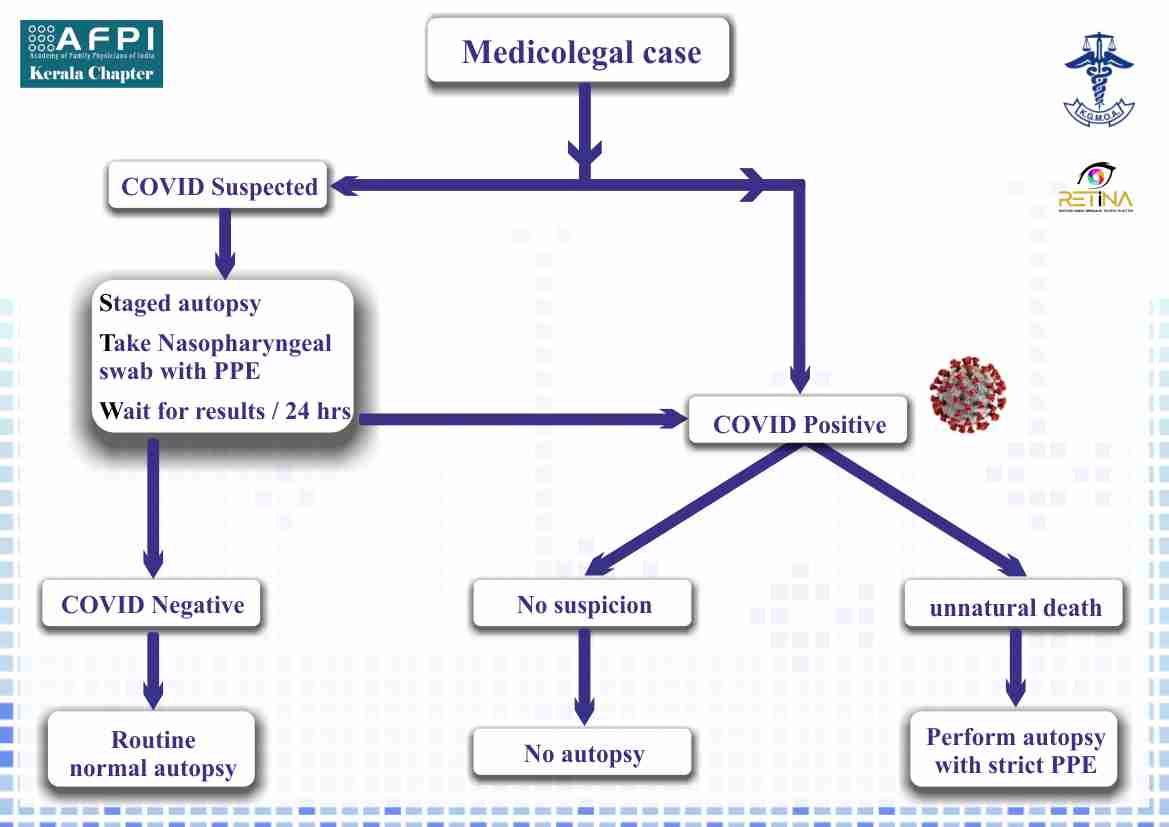Coronavirus Disease 2019 - COVID 19
STANDARD OPERATING PROCEDURE (SOP) FORAUTOPSIES IN CONFIRMED / SUSPECTED CASES OF COVID - 19, SARS COV-2 INFECTION
PREPARED BY : DEPARTMENT OF FORENSIC MEDICINE, MEDICAL COLLEGE, KOTTAYAM
I. PRE - AUTOPSY RISK ASSESSMENT
- Identify and determine from police version, relatives account, information from health care facilities,treatment records; if any in treatedc ases, from sources in the Health Services, the nature of the case - whether COVID positive o rsuspected case.
- NO AUTOPSY IN COVID CONFIRMED CASE
- However if death is under un-natural circumstances, then autopsyhas to be performed.
- In COVIDs uspect case– a staged post mortem examination as follows
- Collect preliminary throat swab (Nasopharyngeal) as per established guidelines with strict compliance to PPE procedures (soon after death).
- Body to be kept in mortuary wrapped in plastic sheet or body bag if available, sanitized with disinfectant solution (videinfra).
- Autopsy to be performed depending results of laboratory investigation.
- Ifnegative–Autopsyshouldbecarriedout.
- Bodystorage temperature–4to60C.
- Disinfection of stretcher and contact surfaces after body is released from cold room.

II. INFORMATION TO BE ASCERTAINED TO CATEGORIZE CASE A SSUSPECTED COVID 19 INFECTION
B.Deceased had symptoms of fever with cough,shortness of breath with following risk factors:
- International travel within 14 days.
- COVID-19 contact within 14 days.
- Symptomatic Health Care Worker with contact history
III. SAFET YPRECAUTIONS TO BE FOLLOWED AT THE TIME OF AUTOPSY.
- Full PPE equipment and handhygienic measures.
- Minimum number of personnel inside dissection room.
- Prevent inadvertent and accidental cuts.
- PM 40 blades andr oundended scissors in order to minimize risk of sharp injuries.
- Careful cutting of organs after stabilizing them using sponge.
- LUNGS – ONLY LUNGS OF THE DEAD, IF HANDLED DURING AUTOPSY IS INFECTIOUS – (MOHFW 15/03/2020)
- Oscillating saw to be used if electric sawa vailable with suction apparatus to remove bone aerosol.
- Needles,syringes and used blade to be disposed in puncture proof container
- Avoid splashing and spillage of body fluids as far as possible.
IV. SAMPLE COLLECTION PROCEDURES (Based on National Institute of Virology (NIV) Recommendation)
- Collect Nasopharyngeal swab (Two swabs in asingle VTM bottle), swabs from lungs(from each lung) and respiratory tract in viral transport medium (VTM).
- Blood sample collected in EDTA bottle.
- Small bits of internal organs (approx.200gm) in sterile bottle (Nopreservative required)
- All samples to be transferred immediately to a thermocolbox; first wrapped in cotton wool,then put in a plastic Zip pouch,then in a plastic container and finally in to the thermocol box containing ice-packs.
- The requisition for required investigations to be placed in another zip pouch which is finally kept above the samples just beneath the lid of thermocol box.
- On top of box label should be affixed stating Post Mortem Number (PM No.), date, identification details of the deceased including address and mentioning ‘AUTOPSY SAMPLE’ (In capitalletters)
- Histopathological examination, if required; Tissue bits are to bepreserved in 10% formalin.
- With respect to sample collected for histopathological examination, particular care must be taken with a sampling of trachea (proximal and distal), lung (hilar region) as well as parenchyma representative of all lobes of both lungs.
- Toxicological analysis if so warranted.
- Thermocol box are to be transferred to concerned virology laboratory at the earliest after proper intimation to Distric tHealth authorities (District Surveillance Officer (DSO)) or designated personnel in DMO office, who will in turn depute dedicated and trained personnel for transmission of sample from the forensic side to concerned testing facility.
V. POST AUTOPSY CORPSE MANAGEMENT
- Wash body with disinfectant,place it in a body bag the outside of which should also be disinfected.
- Disinfection of autopsy room.
- Well ventilate the room during disinfection
- Wash surfaces including floor, walls, autopsy table and other possible contact areas with soap and water and then apply disinfectant for at least 30 minutes in the concentration of 1% Hypochlorite solution
- Wash and clean autopsy instruments similarly; Autoclaving if possible.
- Fumigation of autopsy room or aerosol spraying with disinfectantsolution.
- Cleaning activities to be adequately supervised ensuring the safety and Infection Protection Control(IPC) measures at all stages.
References
1. Briefing of COVID 19: Autopsy practices relating to possible cases of COVID19
(February2020). Royal College of Pathologists.
2. Infection prevention and control of safe management of a dead body in context of
COVID19 .24 th March 2020. Interim Guidelines of WHO
3. Management of Corpse with suspect, probable and confirmed COVID 19 Respiratory
Infection. Italian Interim recommendations. Pathologica Epub.2020.March28.
4.COVID 19 Guidelines on dead body management. Govt. of India. Ministry of Health &
Family Welfare. DGHS.


 Government Orders
Government Orders 